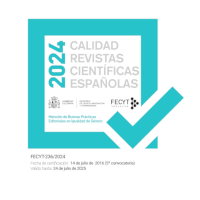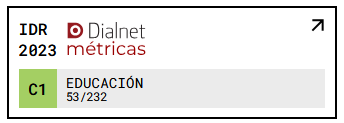Una propuesta para la integración curricular de las áreas de Lengua Castellana e Inglés en el currículo de enseñanza bilingüe para la ESO
DOI:
https://doi.org/10.18172/con.602Keywords:
Enseñanza bilingüe, competencia comunicativa, curriculum integrado de las lenguas, plurilingüismo, ejemplificación curricularAbstract
This article deals with an integrated language and content aproach in our bilingual classes for the Compulsory Secondary Education. Here there are some guidelines, stretegies and techniques for midle and high school language and content teachers who wish to use an integrated aproach between Spanish Language and English in their lessons. The author emphasizes on how the knowledge of linguistic skills on his/her mother tongue (Spanish) can help our students in the process of learning a second language, (English). It is only one ejample in order to make English language input as comprehensible as possible. The focus of this exemplification should be motivated by the content to be learned which will help identify the language skills requiered to learn that content, and the reasoning abilities needed to manipulate it.Downloads
References
Brinton, D. M. (1988). Contend-based Language Instruction: the effectiveness of Adjunct Model. Tesol Quarterly. 22(4).
Brinton, D. M et al. (2000). Content-Based College ESL Instruction. Teaching English as a Second Foreing Language, 4(4).
Camps, A. (2001). El aula como espacio de investigación y reflexión. Investigaciones
en Didáctica de Lengua. Barcelona, Grao, 11.
Consejería de Educación. Junta de Andalucía. (2005). Borrador de Orientaciones para la elaboración del Currículo integrado de las lenguas en los Centros Bilingües. Sevilla: Dirección General de Ordenación y Evaluación Educativa.
Consejería de Educación. Junta de Andalucía. (2005). Plan Andaluz de Fomento del Plurilingüismo. Sevilla. Dirección Gral. de Ordenación y Evaluación Educativa.
Consejo de Europa. (1996). Modern languages: Learning, Teaching, Assessment, A Common European Framework of reference. Strasbourg.
Consejo de Europa. (2001). Marco de referencia europeo para el aprendizaje, enseñanza, y evaluación de las lenguas. Estrasburgo.
Cummins, J. (1999). Research, Ethics, and Public Discourse: The Dabate on Bilingual Education. En Conference of American Association of Higher Education, Washington, D.C.
Cummins, J. y Corson, D. (1997). Bilingual Education. Vol 5. International Encyclopedia of Languaje and Education. Dordrecht: Kluwer Academic Publishers.
De Arriba, C. (2003). La mediación lingüística en la enseñanza de lenguas extranjeras. Tesis Doctoral. Universidad de Barcelona.
Fernández Fontecha, A. (2001). Una selección bibliográfica sobre el método AICLE, (Aprendizaje Integrado de Conocimientos Curriculares y Lengua Extranjera). Contextos Educativos, 4.
Harris, B. y Sherwood, B. (1978). Translation as an innate skill. En D. Gerver y H. W. Sinaiko (eds.), Languages, interpretation and communication. New York: Plenum Press.
Höning, H. G y Kussmaul, P. (1982). Strategie der Übersetzung. Tübingen. Gubter Narr.
Hymes, D. H. (1972). On communicative competence. En J. B. Pride y J. Homes (eds.), Social linguistics: Selected Readings. Baltimore: Penguin.
Hurtado Albir, A. (2001). Traducción y traductología. Madrid: Cátedra.
Krashen, S. (1999). Bilingual Education: Arguments For and (Bogus) Arguments Against. En Georgetown University Roundtable on Languages and Linguistics.
March, D. (2000). Using Languages to Learn and Learning to Use Languages. An Introduction to CLIL for parents and young people. TIE-CLIL.
March, D. y Langé, G. (1999). Implementing Content and Language Integrated Learning. Continuing Education Centre: University of Jyväskylä.
Martínez, J. D. (2003). Hacia una enseñanza de las lenguas extrajeras basada en el desarrollo de la interacción comunicativa. En Didáctica, (Lengua y Literatura),13, 235-261.
Met, M. (1998). Curriculum decision-making in Content-based Language Teaching. Clevedon: Multiligual Matters.
Mohan, B. A. (1986). Language and Content. Reading, M. A.: Addison-Wesley.
Suarez, M.ª L. (2007). Aprendizaje Integrado de Contenidos y Lengua Extranjera (AICLE): una de las claves de la convergencia europea. En II Jornadas Internacionales de Innovación Universitaria: El reto de la Convergencia Europea, Universidad Europea de Madrid, 21-23 septiembre.
Naves, T. y Muñoz C. (2005). Usar las lenguas extrajeras para aprender y aprender a usar las lenguas extranjeras. En TIE-CLIL: Enseñar lenguas extranjeras. Recuperado de http://www.tieclil.org.
Toury, G. (1980). In Search of a Theory of Translation. Tel Avid: The Porter Institute for Poetics and Semiotics.
Van EK, J. A. (1988). Objectifs de l´apprentissage des langues vivantes. Strasbourg, Vol 1.
Wills, W. (1982). Übersetzungswissenschaft. Probleme und Mthoden. Stutgart: Klett.
Downloads
Published
How to Cite
Issue
Section
License
The authors retain copyright of articles and authorize Contextos Educativos. Revista de Educación the first publication. They are free to share and redistribute the article without obtaining permission from the publisher as long as they give appropriate credit to the editor and the journal.
Self-archiving is allowed too. In fact, it is recommendable to deposit a PDF version of the paper in academic and/or institutional repositories.












